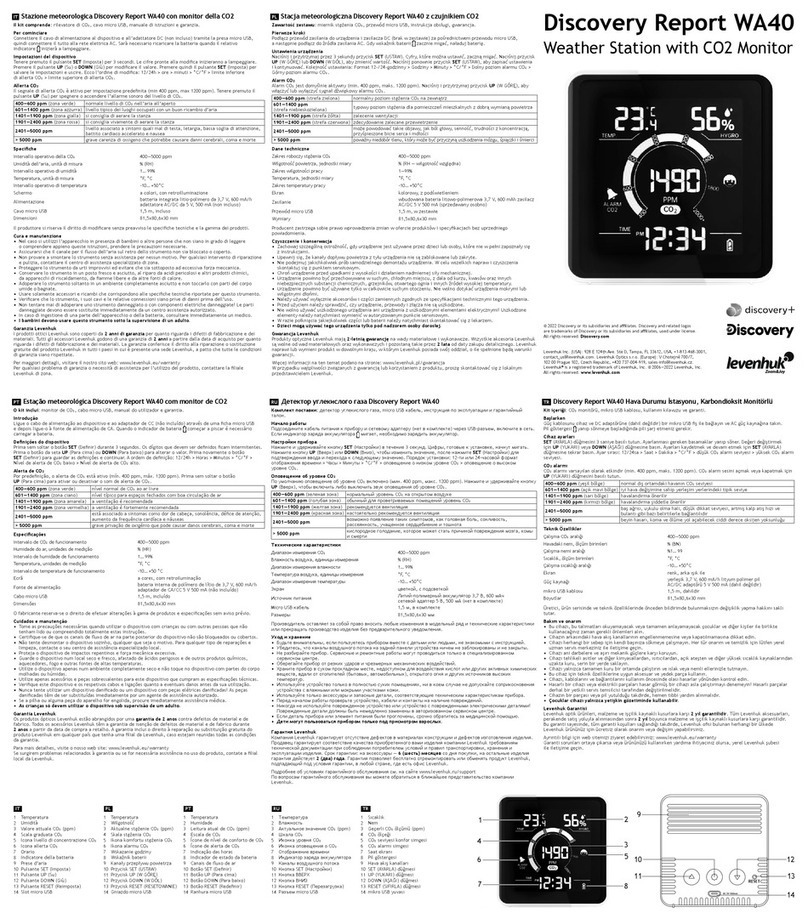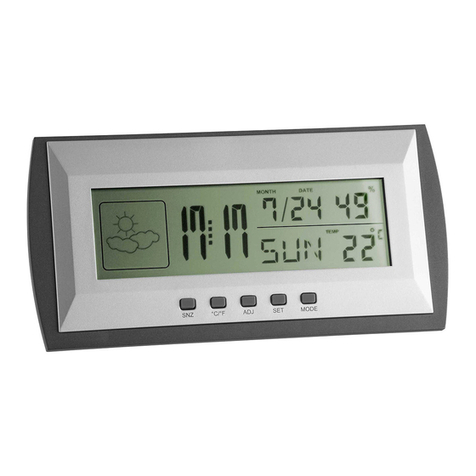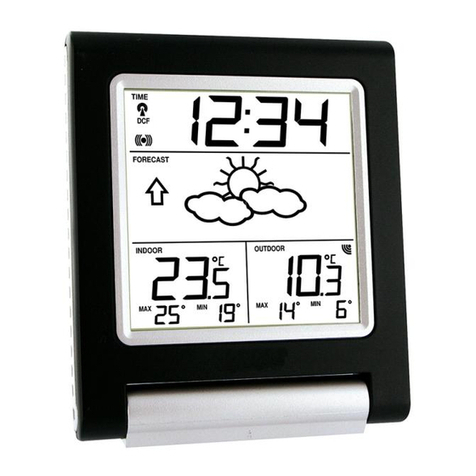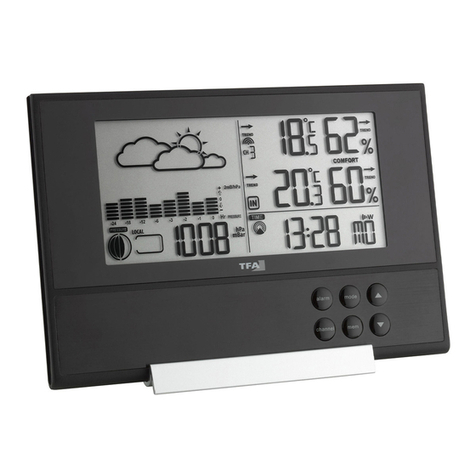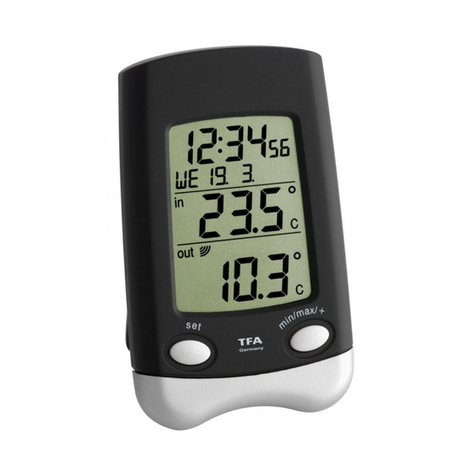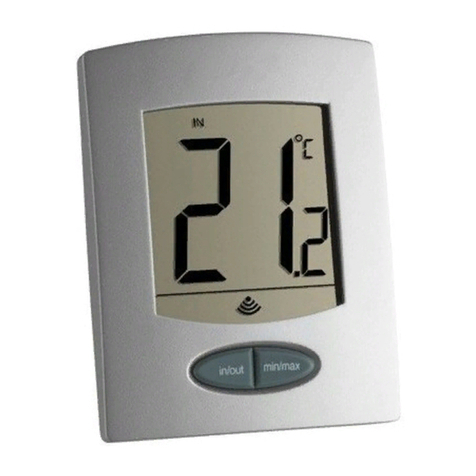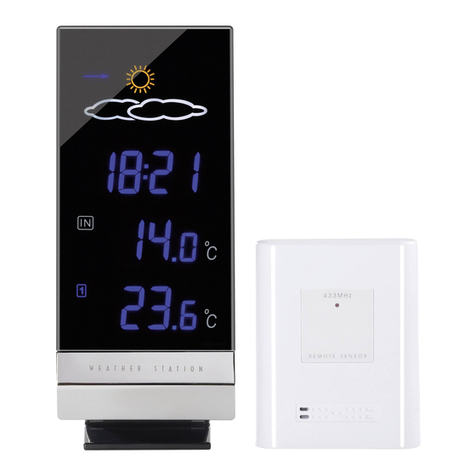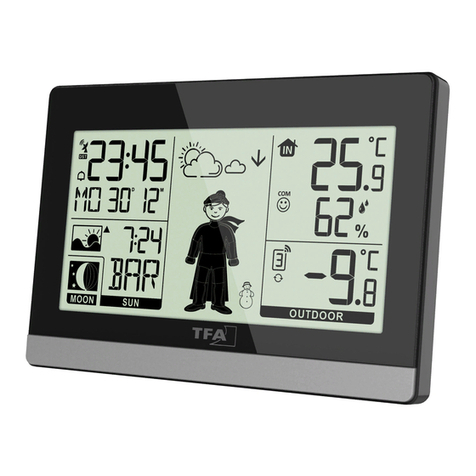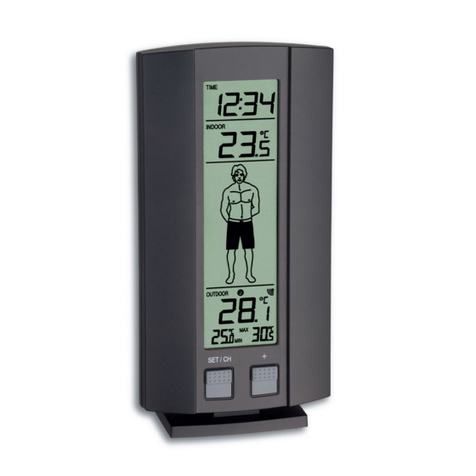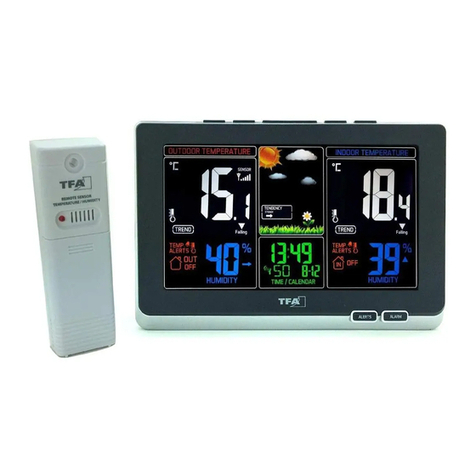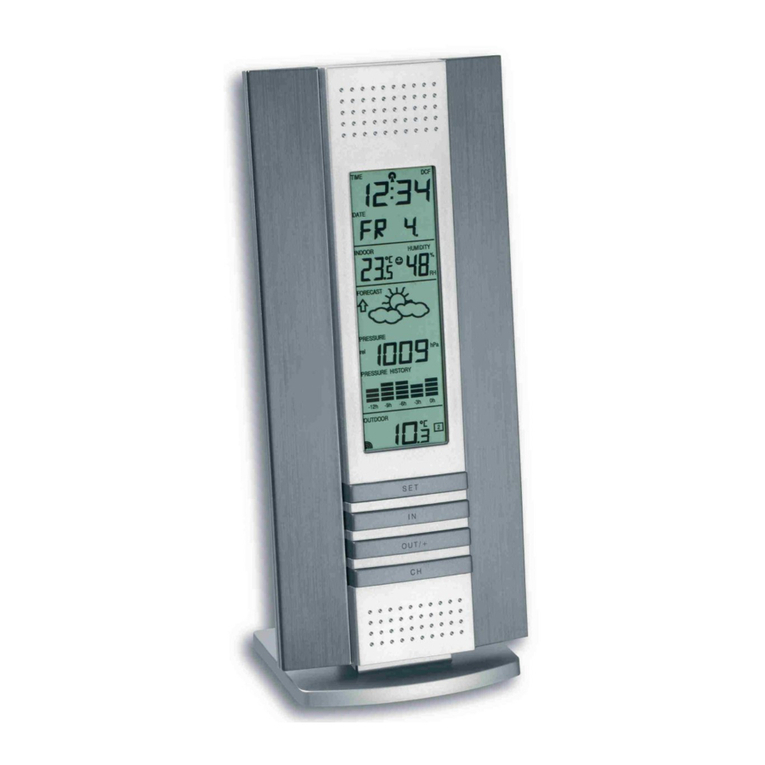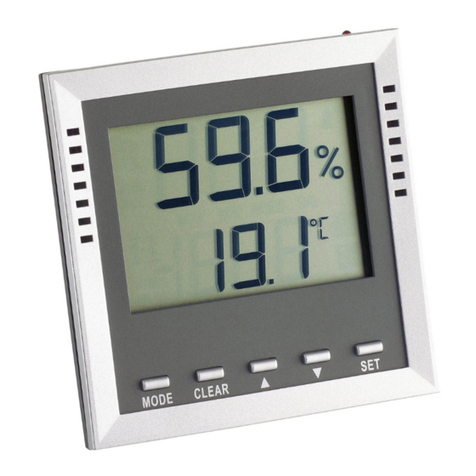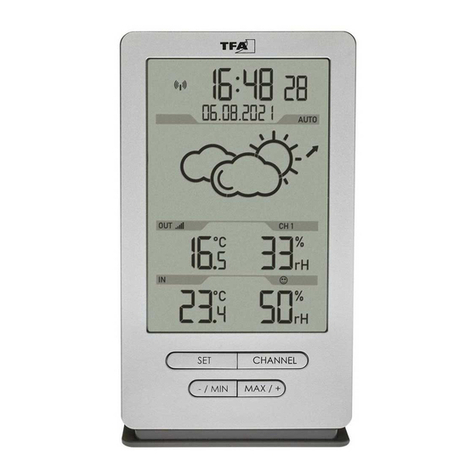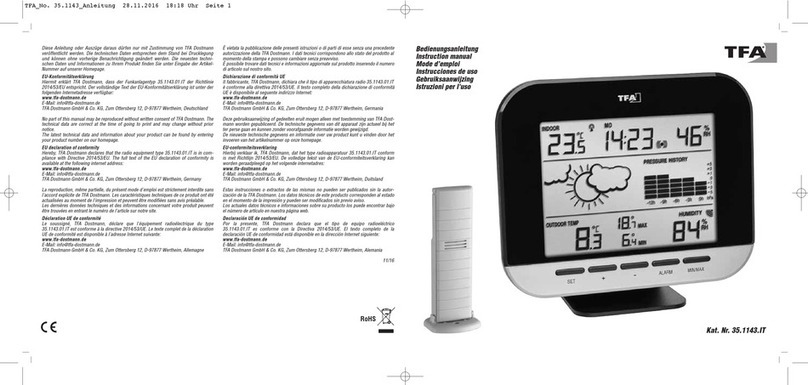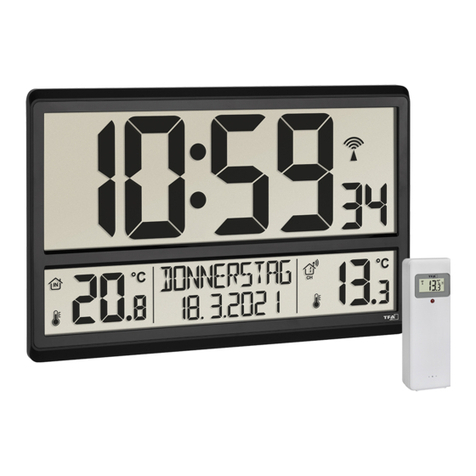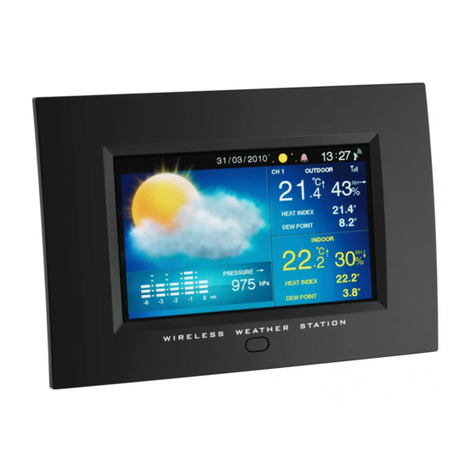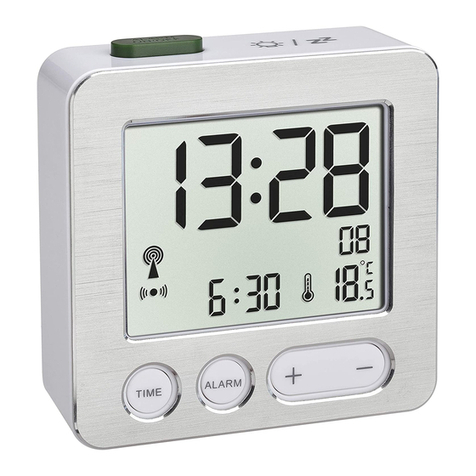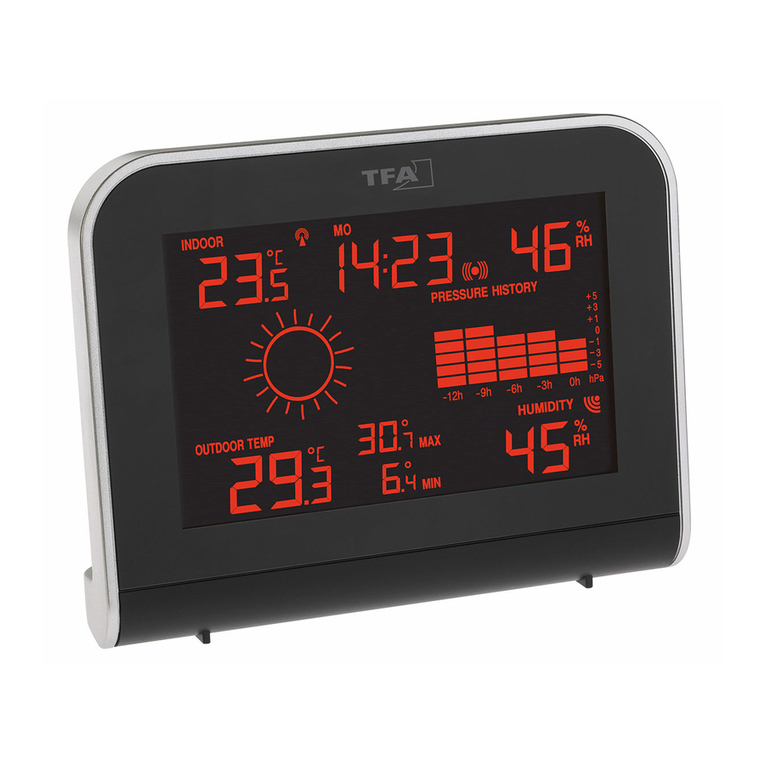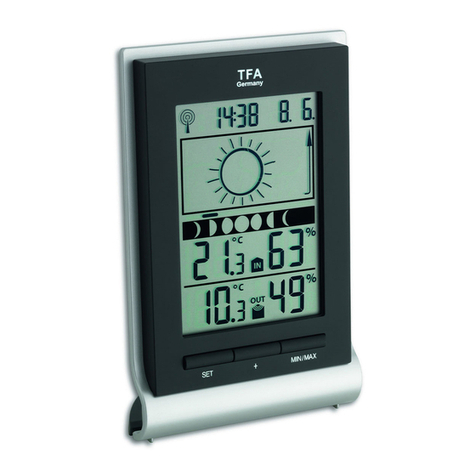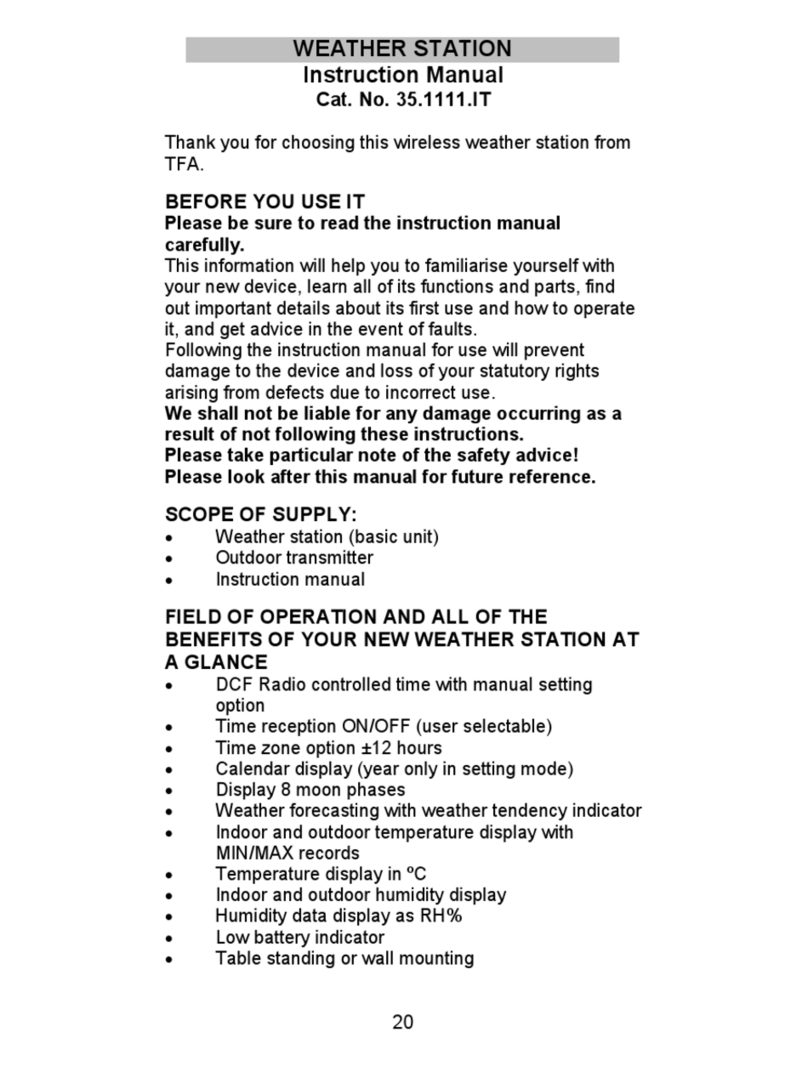98
PRIMAVERA - Funkwetterstation
PRIMAVERA - Funkwetterstation
7.1.2 Einstellung der 12- und 24-Stunden-Anzeige
•
Im Einstellungsmodus können Sie zwischen dem 12- und 24-Stunden-Anzeige auswählen.
•
Im 12-Stunden-Zeitsystem erscheint AM oder PM (nach 12 Uhr) auf dem Display.
7.2 Einstellung des Weckalarms
•
Drücken und halten Sie die ALARM Taste.
•
ALARM, das Alarmsymbol und 0:00 Uhr (Voreinstellung) oder die zuletzt eingestellte Alarmzeit erscheinen
auf dem Display.
•
Die Stundenanzeige blinkt im Display.
•
Sie können mit der +/RCC oder -/°C/°F Taste die Stunden einstellen.
•
Drücken Sie die ALARM Taste noch einmal und Sie können nun die Minuten mit der +/RCC oder -/°C/°F Taste
einstellen.
•
Bestätigen Sie die Eingabe mit der ALARM Taste.
•
Im Display erscheinen TIME, die aktuelle Uhrzeit und das Alarmsymbol. Die Alarmfunktion ist aktiviert.
•
Wenn die eingestellte Alarmzeit erreicht ist, beginnt der Wecker zu klingeln.
•
Das Alarmsymbol blinkt.
•
Drücken Sie auf eine beliebige Taste und der Alarm wird beendet.
•
Wird der Alarm nicht unterbrochen, schaltet sich der ansteigende Alarmton automatisch nach ein paar
Minuten aus und aktiviert sich erneut zur gleichen Alarmzeit wieder.
•
Wenn der Alarmton ertönt, drücken Sie die SNOOZE/LIGHT Taste, um die Snooze-Funktion zu aktivieren.
•
Ist die Snooze-Funktion aktiviert, blinkt Zz auf dem Display.
•
Der Alarm wird für die Dauer von 10 Minuten unterbrochen.
7.2.1 Aktivieren und Deaktivieren der Alarm-Funktion
•
Drücken Sie die ALARM Taste im Normalmodus.
•
ALARM und die eingestellte Alarmzeit erscheinen im Display.
•
Drücken Sie die ALARM Taste noch einmal, um die Alarm-Funktion zu deaktivieren oder aktivieren.
•
Das Alarmsymbol verschwindet oder erscheint.
•
Drücken Sie die SET Taste, um in den Normalmodus zurückzukehren.
•
TIME und die aktuelle Uhrzeit erscheinen im Display.
7.3 Hintergrundbeleuchtung
•
Achtung: Die Hintergrundbeleuchtung im Dauerbetrieb funktioniert nur mit Netzstecker.
•
Drücken und halten Sie die LIGHT HOLD ON/OFF Taste für drei Sekunden, bis ein Signalton zu hören ist, um
die Hintergrundbeleuchtung auszuschalten oder anzuschalten.
•
Drücken Sie die LIGHT HOLD ON/OFF Taste einmal, um die Hintergrundbeleuchtung zu dimmen.
•
Drücken Sie die SNOOZE/LIGHT oder eine beliebige Taste, um die Hintergrundbeleuchtung für ein paar
Sekunden zu aktivieren.
8. USB-Ausgang
•
Mit dem USB Ausgang können Sie Ihr Mobiltelefon oder andere USB taugliche Geräte aufladen. Die Ausgangs-
leistung beträgt 5 Volt …. 1 Ampere. Die Wetterstation kann nicht über den USB-Ausgang betrieben werden.
9. Wettervorhersage-Symbole (Fig. 4)
•
Die Wetterstation unterscheidet fünf unterschiedliche Wettersymbole (Sonnig, teilweise bewölkt, bedeckt,
regnerisch und stürmisch).
•
Die Vorhersage über die Symbolanzeige bezieht sich auf einen Zeitraum von 12 Stunden und gibt lediglich
einen Wettertrend an. Die Genauigkeit beträgt etwa 70 %.
•
Ist es zum Beispiel im Moment wolkig und es wird Regen angezeigt, deutet dies nicht auf eine Fehlfunktion
des Gerätes hin, sondern gibt an, dass der Luftdruck gesunken und eine Wetterverschlechterung zu erwarten
ist, wobei es sich aber nicht unbedingt um Regen handeln muss.
•
Das Sonnensymbol wird auch bei Nacht angezeigt, wenn es sich um eine sternenklare Nacht handelt.
•
Falls die Funkuhr kein DCF-Funksignal empfangen kann (z.B. wegen Störungen, Übertragungsdistanz, etc.),
kann die Zeit manuell eingestellt werden. Das DCF-Empfangszeichen verschwindet und die Uhr arbeitet
dann wie eine normale Quarz-Uhr (siehe „Manuelle Einstellungen”).
6.3.1 Empfang der DCF-Funkzeit
Die Zeitübertragung erfolgt von einer Cäsium Atom-Funkuhr, die von der Physikalisch Technischen Bundesan-
stalt in Braunschweig betrieben wird. Die Abweichung beträgt weniger als 1 Sekunde in einer Million Jahren.
Die Zeit ist kodiert und wird von Mainflingen in der Nähe von Frankfurt am Main durch ein DCF-77 (77.5 kHz)
Frequenzsignal übertragen mit einer Reichweite von ca. 1.500 km. Ihre Funkuhr empfängt das Signal, wandelt
es um und zeigt immer die exakte Zeit an. Auch die Umstellung von Sommer- und Winterzeit erfolgt auto-
matisch. Während der Sommerzeit erscheint auf dem Display DST. Der Empfang hängt hauptsächlich von der
geographischen Lage ab. Im Normalfall sollten innerhalb des Radius von 1.500 km ausgehend von Frankfurt bei
der Übertragung keine Probleme auftauchen.
Bitte beachten Sie folgende Hinweise:
•
Es wird empfohlen, einen Abstand von mindestens 1,5 – 2 Metern zu eventuell störenden Geräten wie Com-
puterbildschirmen und Fernsehgeräten einzuhalten.
•
In Stahlbetonbauten (Kellern, Aufbauten) ist das empfangene Signal natürlicherweise schwächer. In Extrem-
fällen wird empfohlen, das Gerät in Fensternähe zu platzieren und/oder durch Drehen das Funksignal besser
zu empfangen.
•
Nachts sind die atmosphärischen Störungen meist geringer und ein Empfang ist in den meisten Fällen mög-
lich. Ein einziger Empfang pro Tag genügt, um die Genauigkeit zu gewährleisten und Abweichungen unter 1
Sekunde zu halten.
6.4 Einlegen der Batterien in die Basisstation
•
Die Batterien fungieren im Falle eines Stromausfalls als Backup-Batterien.
•
Für eine dauerhafte Hintergrundbeleuchtung benutzen Sie bitte den mitgelieferten Netzstecker.
•
Öffnen Sie das Batteriefach auf der Rückseite der Basisstation.
•
Legen Sie drei neue Batterien 1,5 V AAA polrichtig ein.
•
Schließen Sie das Batteriefach wieder.
7. Bedienung
•
Während der Bedienung werden alle erfolgreichen Eingaben mit einem kurzen Piepton quittiert.
•
Das Gerät verlässt automatisch den Einstellmodus, wenn für längere Zeit keine Taste gedrückt wird.
•
Halten Sie die +/RCC oder -/°C/°F Taste im Einstellmodus gedrückt, gelangen Sie in den Schnelllauf.
7.1 Manuelle Einstellungen
•
Halten Sie die SET Taste im Normalmodus für zwei Sekunden gedrückt, um in den Einstellmodus zu gelan-
gen.
•
Die dauerhafte Hintergrundbeleuchtung schaltet sich automatisch an.
•
TIME ZONE und 0 (Voreinstellung) blinken im Display.
•
Sie können mit der +/RCC oder -/°C/°F Taste die Zeitzonenkorrektur vornehmen.
•
Drücken Sie die SET Taste noch einmal.
•
TIME erscheint im Display.
•
Sie können nun nacheinander die 12- und 24 Stunden-Anzeige (24H - Voreinstellung), die Stunden, die
Minuten, das Jahr (YEAR erscheint im Display), den Monat und den Tag ansteuern und mit der +/RCC oder
-/°C/°F Taste einstellen.
•
Nach Einstellen des Datums wird Ihnen der Wochentag (MON, TUE, WED, THU, FRI, SAT oder SUN erscheint
auf dem Display) automatisch angezeigt.
•
Bestätigen Sie die Eingabe mit der SET Taste.
•
Bei erfolgreichem Empfang des DCF-Funkuhrsignals wird die manuell eingestellte Zeit überschrieben.
7.1.1 Einstellung der Zeitzone
•
Im Einstellungsmodus können Sie die Zeitzonenkorrektur (-12/+12) vornehmen.
•
Die Zeitzonenkorrektur wird benötigt, wenn das DCF Funkuhrsignal empfangen werden kann, die Zeitzone
sich aber von der DCF Funkzeit unterscheidet (z.B. +1=eine Stunde später).

